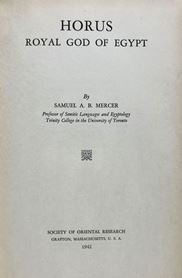
An investigation outdated in senses both egyptological and historical, based on speculative teories about "dynastic race", but still interresting from a curiosity driven point of view. The controversial race theories from the end of XIX and the first half of XX centuries no doubt flawed the monograph, so despite this disadvantage, it is still useful - with corresponding avareness and caution, off course.
We have here specific commentary on early Egyptian history. The first three chapters deal at some length with the predynastic period in Egypt, and the author surveys a great deal of archacological information. The origin of the god Horus, he thinks, is to be found in the broken and tangled skeins of archaeological finds and elaborate hypothesis that form our body of knowledge for this carly period. Breasted reduced фе union of Egypt under Menes to thе rank of а “second union” and it has now been made bе “third.” Before this union, during Ше predynastic period, there were two carlier unions, the second of which gave bе to the prominent myth of Ше bloody encounter between Horus and Set. This struggle, Mercer thinks, represents а historic event. Before this time, during the period of the “second civilization,” Horus had come to Egypt, probably from Mesopotamia (or perhaps from the Hurrians to the north and west), and had settled in thе Egyptian Delta. Appropriating, or mingling with, some earlier deity there, thе cult of this sky-god soon spread throughout the Delta and then over Egypt after his victory over Set, the deity of Ombos.
This is an interesting construction of early Egyptian history. Along with thе main theme, Mercer deals boldly with several other controversial problems. Не favors the view that the inauguration of the calendar was marked not by the Sothic cycle that began in 4241 but by Ше one which began in 2781, and that it was made at Memphis, not at Heliopolis. He contends (p. 59) that the god Osiris was a deified hero who had probably been leader of an invading tribe. He accepts and carriesfurther, belicve, а suggestion of Albright’s, when he suggests that thе rider-god Heron of Egypt, identified by Rostovtzeff and Kazarow with а Thracian rider, was probably an old deity of Syria, known in а Canaanite form and possibly, like Horus, connected with the Hurrians. All this is striking and ingenious interpretation, but, naturally, evidence lacking to make these suggestions more than hypothesis. There is little more that one can do with much of this material than to point out thе possible and probable lines of contact, transmission, and influence.
The material in the remaining chapters is largely factual, and it is a welcome collection of facts and data from many difficult sources. In these chapters material is collected on the name, family, titles, and symbols of Horus, Horus gods, gods identified and gods associated with Horus, thе еуе of Horus, places where Horus was worshiped, representations of Horus, and thе theology and worship of Horus. There is an appendix containing epithets of Horus, one of person names in which the name of Horus appears, and а plate of hieroglyphics to serve chapters iv-vi. There is an adequate index too.

